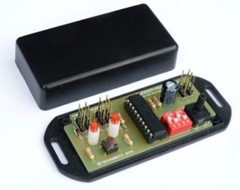
|
|
|
|
RUDDER MIXER
However, at normal 'cruising' speeds I have found that the usual 100% (fixed) mix used in most commercially available mixers results in the boat accelerating whilst turning. In fact, at other than very modest speeds, rudder authority alone is usually sufficient to adequately steer the boat. So with this improved mixer, the user can select a mode which adjusts the proportion of rudder mixing applied depending on the boat's speed. I refer to this as 'dynamic' mixing as opposed to the 'static' (i.e. speed-invariant) mixing offered by normal mixers. Thus at zero speed, 100% mixing is available for high manoeuvrability, tapering off to zero mixing at some speed that is set by the user (e.g. 40% of full speed) when they find that rudder authority alone suffices to steer the boat in question. This is a new concept and received a very positive review in the December 2014 issue of MMI (Marine Modelling International). Download/view a six page (pdf) article covering the detailed operation of this new mixer and information on its availability. |

